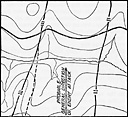
Appendix II
Terrain Appreciation
-
General.--
- Terrain appreciation is the evaluation of the area of probable military operations to determine the effect of the terrain on the lines of action open to opposing forces in the area. The purpose of this appendix is to describe the means of evaluating terrain and to show the effects of terrain on tactical dispositions.
- The character of the area or region of military operations often exercises a decisive influence upon the course of operations. The more important factors to be considered in evaluating terrain include not only natural features such as ridges, streams, bodies of water, woods, and open spaces but also man-made features such as roads, railways, and towns.
- Ground forms such as a succession of ridges and valleys may influence military operations by aiding or hampering the movement of military forces. An advance parallel to the ridges and valleys is mechanically easier than movement across successive ridges.
- The opportunity to utilize favorable terrain features may determine the salient features of the commander's plan of action.
-
Terrain Factors.--No matter what the type of terrain
and no matter what the tactical situation, terrain can always
be evaluated in terms of the following five factors:
-
Observation.
Fields of fire.
Concealment and cover.
Obstacles.
Communications.


